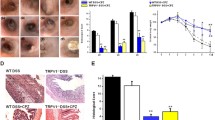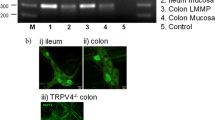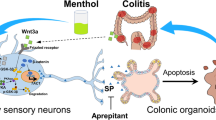Abstract
Primary sensory neurons are important in regard to the initiation and propagation of intestinal in.ammation. The vanilloid receptor subtype-1 (VR-1) is a cation channel located on the sensory nerves that, when stimulated, release proinflammatory peptides. Previous reports have indicated that inhibition of VR-1 with capsazepine (CPZ), a VR-1 antagonist, attenuates dextran sodium sulfate (DSS) colitis in rats. DSS-induced colitis resembles ulcerative colitis with regard to its pathologic features. In this study, we examined the effect of CPZ on trinitrobenzene sulfonic acid (TNBS)-induced colitis, an experimental model of intestinal inflammation that most closely resembles the histologic and microscopic features of Crohn’s disease. Colitis was induced by administering a single enema of 100 mg/ kg TNBS in 50% ethanol via catheter to lightly anesthetized rats. Subsets of rats were treated with either 1 μmol/kg/ml of CPZ or CPZ-vehicle via enema for 6 days. Seven days after TNBS administration, rats were sacrificed and inflammation was assessed using a validated macroscopic damage score (MDS) and by measuring myeloperoxidase (MPO) activity. In addition, histologic examination was performed. TNBS administration resulted in reproducible chronic erosive lesions extending into the muscularis propria and extensive recruitment of neutrophils in the distal colon. MDS and MPO scores were considerably elevated in the TNBS colons when compared with the TNBS vehicle animals. TNBS rats treated with CPZ enemas exhibited a substantial reduction in MDS and MPO scores and demonstrated dramatically improved pathologic findings. Topical CPZ resulted in considerable attenuation of TNBSinduced colitis. These results support the role of VR-1 and sensory neurons with regard to intestinal inflammation.
Similar content being viewed by others
References
Maggio JE, Mantyh PW. Gut tachykinins. In Makhluf GM, ed. Handbook of Physiology. Section 6: The Gastrointestinal System. Bethesda: American Physiology Society, 1989, pp 661–690.
Fischer A, McGregor GP, Saria A, Philippin B, Kummer W. Induction of tachykinin gene and peptide expression in guinea pig nodose primary afferent neurons by allergic airway in.ammation. J Clin Invest 1996;98:2284–2291.
Mantyh CR, Gates TS, Zimmerman RP, Welton M, Passaro E, Vigna SR, Maggio JE, Kruger L, Mantyh PW. Receptor binding sites for substance P but not substance K or neurotensin K are expressed in high concentrations by arterioles, venules, and lymph nodules in surgical specimens obtained from patients with ulcerative colitis and Crohn’s disease. Proc Natl Acad Sci USA 1988;85:3235–3239.
Pothoulakis C, Castagliuolo I, LaMont JT, Jaffer A, O’Keane JC, Snider RM, Leeman SE. CP-96,345, a substance P antagonist, inhibits rat intestinal responses to Clostridium difficile toxin A but not cholera toxin. Proc Natl Acad Sci USA 1994;91:947–951.
Mantyh CR, Pappas TN, Lapp JA, Washington MK, Neville M, Ghilardi JR, Rogers SD, Mantyh PW, Vigna SR. Substance P activation of enteric neurons in response to intraluminal Clostridium difficile toxin A in the rat ileum. Gastroenterology 1996;111:1272–1280.
Mantyh CR, McVey DC, Vigna SR. Extrinsic surgical denervation inhibits Clostridium difficile toxin A-induced enteritis. Neurosci Lett 2000;292:95–98.
Stucchi AF, Shofer S, Leeman S, Materne O, Beer E, McClung J, Shebani K, Moore F, O’Brien M, Becker JM. NK-1 antagonist reduces colonic inflammation and oxidative stress in dextran sulfate-induced colitis in rats. Am J Physiol Gastrointest Liver Physiol 2000;279:G1298-G1306.
Caterina MJ, Schumacher MA, Tominaga M, Rosen TA, Levine JD, Julius D. The capsaicin receptor: A heat-activated ion channel in the pain pathway. Nature 1997;389:816–824.
Bevan S, Hothi S, Hughes G, James IF, Rang HP, Shah K, Walpole CS, Yeats JC. Capsazepine: A competitive antagonist of the sensory neurone excitant capsaicin. Br J Pharmacol 1992;107:544–552.
Kihara N, de la Fuente SG, Fujino K, Takahashi T, Pappas TN, Mantyh CR. Vanilloid receptor-1 containing primary sensory neurons mediate dextran sulfate sodiuminduced colitis in rats. Gut 2003;52:713–719.
Sykes AP, Bhogal R, Brampton C, Chander C, Whelan C, Parsons ME, Bird J. The effect of an inhibitor of matrix metalloproteinases on colonic inflammation in a trinitrobenzenesulphonic acid rat model of inflammatory bowel disease. Aliment Pharmacol Ther 1999;13:1535–1542.
Fischer A, McGregor GP, Saria A, Philippin B, Kummer W. Induction of tachykinin gene and peptide expression in guinea pig nodose primary afferent neurons by allergic airway inflammation. J Clin Invest 1996;98:2284–2291.
Okabe T, Hide M, Koro O, Yamamoto S. Substance P induces tumor necrosis factor-alpha release from human skin via mitogen-activated protein kinase. Eur J Pharmacol 2000;398:309–315.
Saban R, Saban MR, Nguyen NB, Lu B, Gerard C, Gerard NP, Hammond TG. Neurokinin-1 (NK-1) receptor is required in antigen-induced cystitis. Am J Pathol 2000;156:775–780.
Nathan JD, Patel AA, McVey DC, Thomas JE, Prpic V, Vigna SR, Liddle RA. Capsaicin vanilloid receptor-1 mediates substance P release in experimental pancreatitis. Am J Physiol Gastrointest Liver Physiol 2001;281:G1322-G1328.
Holzer P. Implications of tachykinins and calcitonin gene-related peptide in inflammatory bowel disease. Digestion 1998; 59:269–283.
McVey DC, Vigna SR. The capsaicin VR-1 receptor mediates substance P release in toxin A-induced enteritis in rats. Peptides 2001;22:1439–1446.
Garside P. Cytokines in experimental colitis. Clin Exp Immunol 1999;118:337–339.
Neurath MF, Fuss I, Pasparakis M, Alexopoulou L, Haralambous S, Meyer zum Buschenfelde KH, Stober W, Kollias G. Predominant pathogenic role of tumor necrosis factor in experimental colitis in mice. Eur J Immunol 1997;27:1743–1750.
Stallmach A, Marth T, Wei B, Wittig BM, Hombach A, Schmidt C, Neurath M, Zeitz M, Zeuzem S, Abken H. An interleukin 12 p40-IgG2b fusion protein abrogates T cell mediated inflammation: Anti-inflammatory activity in Crohn’s disease and experimental colitis in vivo. Gut 2004; 53:339–345.
Author information
Authors and Affiliations
Additional information
This work was supported by the American Surgical Association Fellowship Award and a Career Development Award from the American Society of Colon and Rectum Surgery (C.R.M.).
Rights and permissions
About this article
Cite this article
Fujino, K., Takami, Y., de la Fuente, S.G. et al. Inhibition of the vanilloid receptor subtype-1 attenuates tnbs-colitis. J Gastrointest Surg 8, 842–848 (2004). https://doi.org/10.1016/j.gassur.2004.07.011
Issue Date:
DOI: https://doi.org/10.1016/j.gassur.2004.07.011




